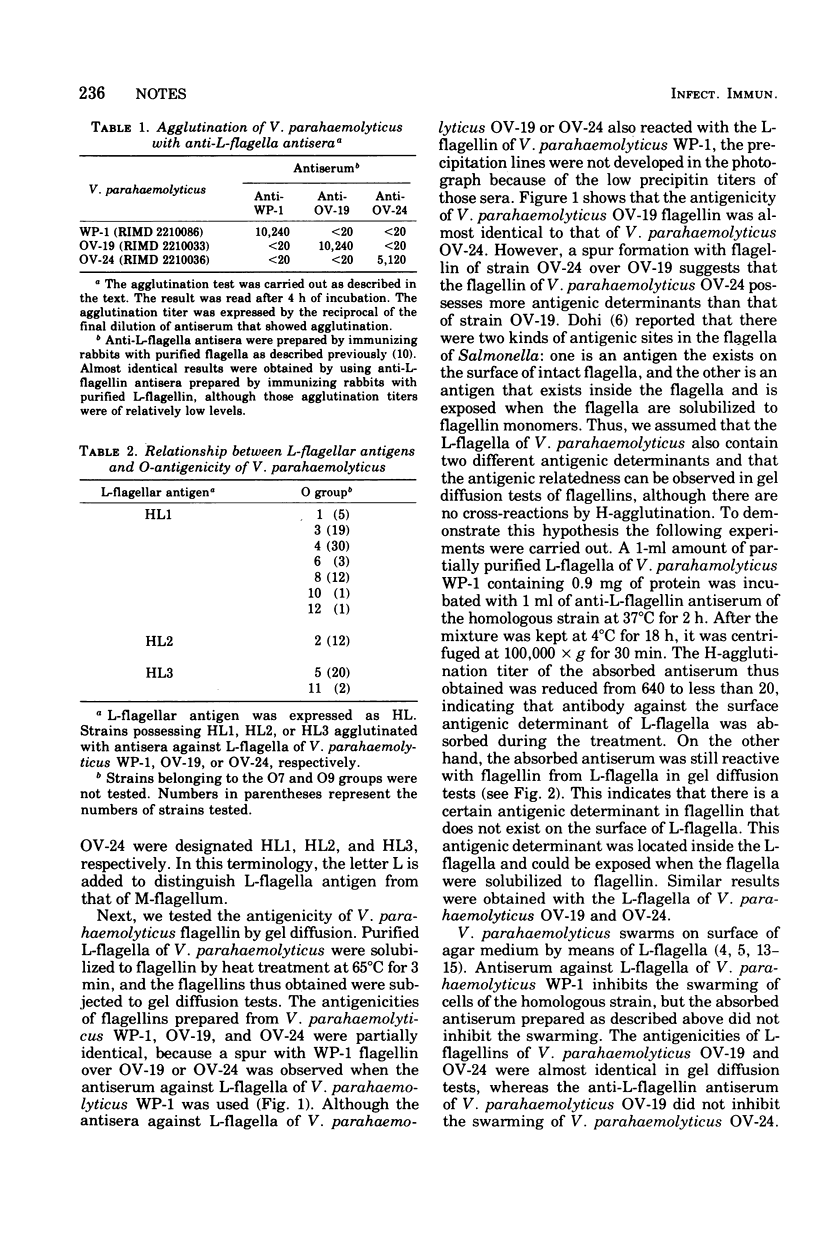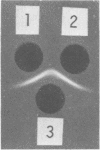Abstract
Cells of Vibrio parahaemolyticus treated with Formalin agglutinated with anti-lateral flagella antiserum. On the basis of agglutination tests, antigens of lateral flagella were divided into three groups. HL1, HL2, and HL3. However, in gel diffusion tests, flagellins prepared from strains belonging to different groups showed a common antigenicity. It is assumed that these results are due to the existence of two distinct antigenic determinants in the lateral flagella. One of them exists on the surfaces of the flagella and is responsible for H-agglutination, and the other exists inside the flagella and is exposed when the flagella are solubilized to flagellin monomers.
Full text
PDF


Images in this article
Selected References
These references are in PubMed. This may not be the complete list of references from this article.
- Allen R. D., Baumann P. Structure and arrangement of flagella in species of the genus Beneckea and Photobacterium fischeri. J Bacteriol. 1971 Jul;107(1):295–302. doi: 10.1128/jb.107.1.295-302.1971. [DOI] [PMC free article] [PubMed] [Google Scholar]
- Baumann P., Baumann L., Mandel M. Taxonomy of marine bacteria: the genus Beneckea. J Bacteriol. 1971 Jul;107(1):268–294. doi: 10.1128/jb.107.1.268-294.1971. [DOI] [PMC free article] [PubMed] [Google Scholar]
- Baumann P., Baumann L., Reichelt J. L. Taxonomy of marine bacteria: Beneckea parahaemolytica and Beneckea alginolytica. J Bacteriol. 1973 Mar;113(3):1144–1155. doi: 10.1128/jb.113.3.1144-1155.1973. [DOI] [PMC free article] [PubMed] [Google Scholar]
- De Boer S. E., Golten C., Scheffers W. A. Effects of some chemical factors on flagellation and swarming of Vibrio alginolyticus. Antonie Van Leeuwenhoek. 1975;41(4):385–403. doi: 10.1007/BF02565083. [DOI] [PubMed] [Google Scholar]
- LEIFSON E. Staining, shape and arrangement of bacterial flagella. J Bacteriol. 1951 Oct;62(4):377–389. doi: 10.1128/jb.62.4.377-389.1951. [DOI] [PMC free article] [PubMed] [Google Scholar]
- Miwatani T., Shinoda S., Tamura T., Nishimune H., Tomaru A., Yoshihara A., Fujino T. Antigens of Vibrio parahaemolyticus. I. Preparation of specific antisera to somatic (O) antigen and their application in antigen analysis of Vibrio parahaemolyticus. Biken J. 1969 Mar;12(1):9–15. [PubMed] [Google Scholar]
- Shinoda S., Honda T., Takeda Y., Miwatani T. Antigenic difference between polar montrichous and peritrichous flagella of Vibrio parahaemolyticus. J Bacteriol. 1974 Nov;120(2):923–928. doi: 10.1128/jb.120.2.923-928.1974. [DOI] [PMC free article] [PubMed] [Google Scholar]
- Shinoda S., Okamoto K. Formation and function of Vibrio parahaemolyticus lateral flagella. J Bacteriol. 1977 Mar;129(3):1266–1271. doi: 10.1128/jb.129.3.1266-1271.1977. [DOI] [PMC free article] [PubMed] [Google Scholar]
- Ulitzer S. The mechanism of swarming of Vibrio alginolyticus. Arch Microbiol. 1975 Jun 20;104(1):67–71. doi: 10.1007/BF00447301. [DOI] [PubMed] [Google Scholar]
- Ulitzur S. Induction of swarming in Vibrio parahaemolyticus. Arch Microbiol. 1974;101(4):357–363. doi: 10.1007/BF00455952. [DOI] [PubMed] [Google Scholar]
- Yabuuchi E., Miwatani T., Takeda Y., Arita M. Flagellar morphology of Vibrio parahaemolyticus (Fujino et al) Sakazaki, Iwanami and Fukumi 1963. Jpn J Microbiol. 1974 Jul;18(4):295–305. doi: 10.1111/j.1348-0421.1974.tb00813.x. [DOI] [PubMed] [Google Scholar]




